Books by Sari Nauman
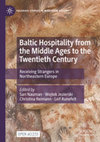
Palgrave Studies in Migration History, 2022
Reflecting debate around hospitality and the Baltic Sea region, this open access book taps into w... more Reflecting debate around hospitality and the Baltic Sea region, this open access book taps into wider discussions about reception, securitization, xenophobia, and attitudes towards migrants and strangers. Focusing on coastal and urban areas, the collection presents an overview of the responses of host communities to guests and strangers in the countries surrounding the Baltic Sea, from the early eleventh century to the twentieth. The chapters investigate why and how diverse categories of strangers, including migrants, war refugees, prisoners of war, merchants, missionaries, and vagrants, were portrayed as threats to local populations or as objects of their charity, shedding light on the current predicament facing many European countries. Emphasizing the Baltic Sea region as a uniquely multi-layered space of intercultural encounter and conflict, this book demonstrates the significance of Northeastern Europe to migration history.

Private/Public in 18th-Century Scandinavia, eds: Sari Nauman & Helle Vogt (London: Bloomsbury), 2022
This volume explores the private in the public. Focusing on the two states of 18th century Scandi... more This volume explores the private in the public. Focusing on the two states of 18th century Scandinavia – Denmark-Norway and Sweden, incorporating Finland – it argues for including the periphery on its own terms in the grand narrative of the rise of the private. Moreover, it argues for the spatialization but also temporalization of the term. The private is something that people did; the potentiality for privacy was always there. But when and why did it surface?
Included are investigations of the usage and multiple meanings of the term itself – the private – following traces in private conversations, parliamentary debates, letters, court records and newspapers. This linguistic perspective is combined with a conceptual and physical one, studying buildings and floor plans, furniture, ordinances and corruption. Most chapters centre on the major cities of the region – Copenhagen and Stockholm – but other cities as well as rural life are considered.
Private actions and private lives took place within public actions and public lives, not in isolation from them. By looking at the interaction between private and public, rather than treating the two notions as distinct and antagonistic, the studies collected here let us see how early modern people navigated the private aspects of life, along with all the potential dangers and benefits that accompanied them.
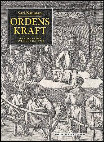
Lund: Nordic Academic Press, 2017
Political oaths were widespread in medieval times, but all over Europe their use dwindled in the ... more Political oaths were widespread in medieval times, but all over Europe their use dwindled in the early modern period, resulting in the institution being dismantled in many states. In previous research, this decay has been explained by pointing to the emergence of the state in this period, through processes such as bureaucratization, nationalization, and confessionalization, and, later, secularization. However, as some oaths are still in use in modern state systems, the swearing of them seems to be compatible with modern – bureaucratized, nationalized, and secularized – states. If nothing else, this indicates that the standard model for explaining changes in European oath-taking must be questioned.
The main purpose of this dissertation is to analyse why political oaths were used in Sweden in the sixteenth and seventeenth centuries, as well as to explain why the usages changed. It is argued that oaths were performative means of instilling trust in a political relationship. Trust was accomplished by an oral utterance, during which the swearer claimed the position of a trustworthy subject. The study encompasses not only how the force of oaths was created, but also how uncertainty regarding the subject’s trustworthiness was handled, by examining its usage in coronations, rebellions, wars and political meetings.
The dissertation has four conclusions. First, not only the use of oaths but also the oath event itself underwent changes during the period studied, leading to changes in its performative force. Second, the shaping of the oath event depended on the degree of uncertainty in the specific political relationship. Third, while in the sixteenth century oaths were used to establish trust in political relationships, in the seventeenth century they were re-directed to establish control. Fourth, the shift from trust to control reflected the rise of a written political culture. When political relationships shifted from being characterized by presence and personal contact, to being characterized by distance and impersonal delegation, written oaths were better suited to the situation. Ultimately, the written form transformed the action, for the ability of a political oath to instil trust was linked to its orality. What a written oath could do, though, was help establish control.
Järn i elden: Kön, makt och relationer 1600-2020, 2020
För att förstå vår samtid måste vi studera hur förändring och seghet samverkat genom historien. J... more För att förstå vår samtid måste vi studera hur förändring och seghet samverkat genom historien. Järn i elden innehåller texter som på olika sätt tar upp denna tematik, särskilt vad gäller kön, makt och olika typer av relationer. Artiklarna är indelade i tre sektioner - civilt och militärt, genus och resurser, samt hushåll och relationer - och sträcker sig kronologiskt över 400 års historia. Här diskuteras ämnen som knektutskrivningar, fyrvaktarfamiljer, hushållskonflikter, musikliv, statyresande, beskattningssystem, sjukförsäkringar, arvsrätt, säkerhetshot och livsberättelser.
Bokens författare är alla tidigare eller nuvarande doktorander till Maria Sjöberg, professor i historia vid Göteborgs universitet.
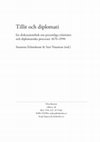
Opuscula Upsaliensis 2019, 2019
Jämförelser mellan tidigmodern och modern tid är ovanliga inom forskning om diplomati. Att centra... more Jämförelser mellan tidigmodern och modern tid är ovanliga inom forskning om diplomati. Att centrala begrepp som stat och diplomat är anpassade för ett västerländskt system som egentligen inte var i funktion förrän efter 1815 motverkar sådana försök, och anakronistiska definitioner riskerar att dölja en mångfald av diplomatiska aktörer och strategier.
Men rumsliga och tidsliga skillnader inom diplomati har också överdrivits. Därför presenterar historikerna Susanna Erlandsson och Sari Nauman i den här diskussionsboken en begreppsapparat som möjliggör såväl diakrona som synkrona jämförelser av diplomatiska praktiker. Sökljuset riktas bort från stater och officiella aktörer, som är svåra att definiera för tidigare perioder, mot individuella aktörer och deras personliga relationer med varandra. Frågan om hur individerna gör för att skapa tillit inom den diplomatiska relationen placeras i fokus. Medan behovet av tillit ständigt är aktuellt, är metoderna för att uppnå den kontextberoende. Därmed möjliggör begreppsapparaten såväl jämförelser över tid och rum som studier av kontinuitet och förändring.
Begreppsapparaten testas av sex framstående diplomatihistoriker på skilda historiska perioder och kontexter. Tillsammans demonstrerar de begreppens potential och deras fortsatta utmaningar.
Articles & Chapters by Sari Nauman
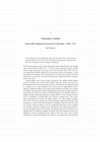
Refugee Politics in Early Modern Europe, ed. by David de Boer and Geert H. Janssen, 2024
This chapter analyses how internally displaced persons (IDPs) articulated belonging and alienatio... more This chapter analyses how internally displaced persons (IDPs) articulated belonging and alienation in a period of composite states and empires before nationality became an expected point of reference. The people fleeing from Sweden’s Finnish and Baltic territories during the Great Northern War (1700–1721) has throughout history generally been depicted as refugees, and they used this term to position themselves toward the Swedish authorities at the time. To them, ‘refugee’ signalled a perilous position with a legitimate claim for protection, a claim the king granted them as Swedish subjects. However, they also designated themselves as strangers to their recipient communities, highlighting how belonging and alienation were not contrasting positions but rather concomitant experiences of the IDPs. By tracing these terms’ biblical, linguistic, and social meanings, the chapter argues that early modern IDPs were, and indeed placed themselves, in the precarious situation of insiders and outsiders – at the same time.
Karolinska förbundets årsbok, 2023
The article investigates how the word "flykting" (eng. refugee) entered the Swedish language, wit... more The article investigates how the word "flykting" (eng. refugee) entered the Swedish language, with forced migrants fleeing from Finland and Sweden's Baltic territories during the great northern war. I argue that this word and the narratives of the refugees must be understood from a broader perspective, taking into account previous experiences of refuge in Europe and across the Atlantic.
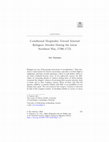
Baltic Hospitality from the Middle Ages to the Twentieth Century, 2022
In this chapter, Sari Nauman studies the reception of refugees from the Baltic area and Finland i... more In this chapter, Sari Nauman studies the reception of refugees from the Baltic area and Finland in Stockholm, Sweden, during the Great Northern War. The investigation analyses security measures, paying particular attention to how central and local authorities vs. refugees addressed the situation and depicted the measures taken. What security issues and possible threats did the parties involved identify? Who or what was identified as the main referent object, that is the one being threatened – the individual or the state? Which security measures did the parties take, based on their perception of the situation? How did they react to such security measures?
Starting with ordinances and instructions, Nauman investigates the authorities’ perspective in trying to safeguard their communities at the arrival of thousands of refugees during wartime. The refugee’s perspective is analysed through petitions and letters of grievances sent to worldly and ecclesiastical authorities.
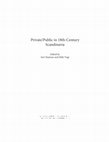
Private/Public in 18th-Century Scandinavia, 2022
Based on a case study of a peasant rebellion in central Sweden, 1710, this article argues for the... more Based on a case study of a peasant rebellion in central Sweden, 1710, this article argues for the active use made of notions of private and public in early modern rural communities. During the rebellion, a large group of peasants murdered a bailiff by dragging him repeatedly across the threshold of a courthouse, ultimately leaving his dead body on the road. The separation of spaces corresponded to the actions taken against the bailiff, highlighting the nature of his perceived crimes. While official accusations were made inside the official building of the courthouse, violent retribution for these crimes was carried out in public, in the courtyard. In displaying their punishment, the peasants made claims about justice and fairness, and called for other peasants to witness their actions. The road signalled the expulsion of the bailiff from communal space; by dragging his body there, the peasants marked him as an outlaw. Finally, the article analyzes the accusations brought against the bailiff that he had taken private gain in his public office. Ultimately, the vengeance exacted upon the bailiff degraded him from a public office-holder to a disgraceful private man, a degradation that further aggravated the peasants’ crime in the eyes of the state.
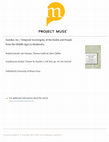
Scandinavian Studies, 2022
The notion of sovereignty remains one of the most scholarly and historically contested concepts. ... more The notion of sovereignty remains one of the most scholarly and historically contested concepts. In this article we argue that historians’ absorption of sovereignty’s spatiality needs to be complemented by an investigation of its temporality. By tracing the late medieval and early modern connections between political theology and economic teleology—between the permanence of political incorporation and perpetuation of the administrative apparatus —this article outlines a new research agenda and a novel vantage point for investigating state formation in Sweden. The article scrutinizes the following four areas: (1) The ideas of incorporation and representation of the realm and the Swedish people in late medieval historiography; (2) the transformation of political loyalty from personal oaths of and to the monarchs to popular, national loyalty; (3) the transformation of tax-collection from occasional to perpetual; and (4) the transition from personal debts of monarchs to state debt.
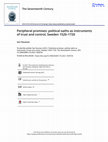
The Seventeenth Century, 2021
This article analyses how written culture influenced the relationship between kings and subjects ... more This article analyses how written culture influenced the relationship between kings and subjects during the seventeenth century by examining the use of political oaths. The use of political oaths dwindled in Europe at this time and researchers have placed the polemic scholarly debate on oaths in England at the centre of change. This article challenges this singular narrative by focusing on the peripheral state of Sweden and shows how underlying societal changes contributed to undermine oath-swearing. It argues that the performative nature of oaths was decisive in their usage. Oaths were aimed at guaranteeing coherence between actions and statements. The speech act's objective was to establish trust between king and subjects. As such, oaths were adapted to an oral culture characterised by presence and spoken promises. During the seventeenth century, the emerging literate culture promoted written statements that enabled control that became diametrically opposed to such trust. Consequently, oaths lost their performative force to instill trust.
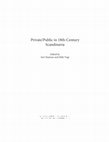
Private/Public in 18th-Century Scandinavia, 2022
This chapter explores the private in the public. Focusing on the two states of 18th century Scand... more This chapter explores the private in the public. Focusing on the two states of 18th century Scandinavia – Denmark-Norway and Sweden, incorporating Finland – it argues for including the periphery on its own terms in the grand narrative of the rise of the private. Moreover, it argues for the spatialization but also temporalization of the term. The private is something that people did; the potentiality for privacy was always there. But when and why did it surface?
Private actions and private lives took place within public actions and public lives, not in isolation from them. By looking at the interaction between private and public, rather than treating the two notions as distinct and antagonistic, this introduction highlights how early modern people navigated the private aspects of life, along with all the potential dangers and benefits that accompanied them.

in: Sari Nauman, Wojtek Jezierski, Christina Reimann, Leif Runefelt (eds.), Baltic Hospitality from the Middle Ages to the Twentieth Century: Receiving Strangers in Northeastern Europe (Cham: Palgrave Macmillan, 2022), pp. 1-29, 2022
The introductory chapter presents the thematic, geographical, and chronological scope of the volu... more The introductory chapter presents the thematic, geographical, and chronological scope of the volume and explicates its guiding questions and conceptual framework. Our focus is on the Baltic Sea region, considered as a multi-layered space of intercultural encounter and conflict and its specific legacy of hospitality. In terms of guiding concepts for the empirical chapters, this introduction combines issues of host–guest relations with the problems of securitization. It is our contention that hospitality in Baltic migration contexts, from the turn of the first millennium until the twentieth century and beyond, triggered security issues both on the part of arriving strangers and receiving host communities. Why and how were multifarious categories of guests and strangers—migrants, war refugees, prisoners of war, merchants, missionaries, vagrants, vagabonds, etc.—portrayed as threats to local populations or as objects of their charity? Under what circumstances did hospitality turn into hostility? How was hospitality practiced and contained spatially? By focusing predominantly on coastal contexts as spaces for meetings and confrontations, we decouple the study of hospitality and migration from state-centered methodology. Instead, we offer a close-up view on hospitality dilemmas and practices of dealing with arriving guests and strangers, which we consider in transhistorical perspective. These conceptual themes and problems are fleshed out in the presentation of the individual chapters.

Journal of the British Academy, 2021
This article introduces the concept of securitisation for early modern studies. It identifies sec... more This article introduces the concept of securitisation for early modern studies. It identifies security studies' implicit state-centric approach as one of the main culprits for early modern scholars' hesitance to use the concept and argues that, for historians, there is a twofold problem with placing the state at the centre of research. The problem pertains to how scholars have dealt with the interactions between time and space when approaching the state. First, the definition of state is space-and time-centred; it is built to accommodate the system of 19th-and 20th-century Europe, with the idea of the sovereign state at its centre. To fit the early modern period, we need to acknowledge the role of other entities and varieties in securitisation processes. Second, the concept of the state needs to be problematised by acknowledging the changing nature of its space-that is, by temporalising its spatiality. The second part of the text focuses on two interconnected areas especially prone to securitisation, where historians have much to offer those studying securitisation processes: migration and border making. Questions of how to control the future and how to secure it are most often translated into a spatial problem: as long as the border is secure, change will not enter. By focusing on local responses to perceived security threats and studying the effects that measures taken had on local communities, historians can seek not only to understand the underlying assumptions made about the future by our objects of investigation, but also to gain considerable insight into de-securitisation processes.
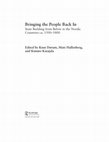
Bringing the People Back In: State Building from Below in the Nordic Countries ca. 1500-1800, ed. K. Dørum, M. Hallenberg & K. Katajala, 2021
Previous research has shown how peasant rebellions were translated by local and central elite int... more Previous research has shown how peasant rebellions were translated by local and central elite into institutional change. But not all statebuilding measures were meant to build the state as we know it and states rarely moved in a single direction. In this article, I argue that historians, dealing with change and continuity, require a definition of the state that acknowledges and problematizes the transformational and instable nature of the international order.
I propose that the concept of recognition can be used to challenge the perception of states as sovereign and continuous entities and highlight challenges towards the statebuilding process. Based on a case study in Sweden 1719, I show how states’ recognition of subjects’ political agency enabled negotiations during wartime rebellions. Furthermore, subjects could withhold or retract their recognition of a state. Their actions signalled the breakdown of the sovereign state, at least temporarily, and thwarted the statebuilding process.

Migrants and the making of the urban-maritime world: Agency and mobility in port cities, c. 1570–1940. Eds: Christina Reimann & Martin Öhman. New York: Routledge, 2020
In this chapter, I investigate the control practices of the Swedish state, as they were actualize... more In this chapter, I investigate the control practices of the Swedish state, as they were actualized in the specific case of the migrant Annika Åhqvist in Helsingborg 1744, as well as the efforts of the migrant to escape control. Passports were supposed to be necessary for all travel, but by presenting herself as a respectable widow, Annika managed to travel all through mainland Sweden. It was not until she reached the port city that migration controls were enacted. Lack of proper papers, suspicious behavior, and rumors led to Annika being arrested and questioned, effectively hindering her from passing.
However, the case study also demonstrates the shortcomings of the port city’s control network. Had Annika timed her journey better and been better informed on the politics of the city, she might have managed to slip through. As shown in the study, the city inhabitants were generally willing to help the passing stranger, especially if they could expect compensation, even if this meant breaking the law. As such, the investigation demonstrates the conditions as well as social costs of fleeting hospitality and civil inattention.
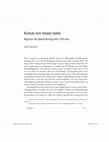
Järn i elden: Kön, makt och relationer 1600-2020, 2020
Den 25 januari 1744 lämnade Annika Åqvist sin välbeställda rusthållargård i Roslagen för att ta s... more Den 25 januari 1744 lämnade Annika Åqvist sin välbeställda rusthållargård i Roslagen för att ta sig till Hamburg och förena sig med sin make Olof. 1 Ett drygt halvår tidigare hade Olof hastigt tvingats lämna landet misstänkt för att ha uppmanat sina sockenmän att ansluta sig till dalupproret. Hans flykt misstänkliggjorde även Annika och hon utgav sig därför under sin resa för att vara änka och försökte hålla sitt mål hemligt. I Helsingborg blev dock myndigheterna misstänksamma, och Annika arresterades. Under den följande rättegången skärskådade rådhusrätten Annikas inblandning i hennes makes förehavanden, men inte nog med det: rättsprotokollen visar hur magistraten i Helsingborg granskade Annikas resande i stort, och de ansträngde sig för att utreda Annikas samtliga kontakter och handlingar. 2 I föreliggande artikel analyserar jag den tidigmoderna svenska statens misstänkliggörande av Annikas resande och rörlighet. Utifrån en enskild fallstudie undersöker jag hur lokala överheter formulerade migranten som ett säkerhetsproblem, och diskuterar vilket hot Annika utgjorde mot magistraten och 1. Artikeln ingår i projektet "Baltic Hospitality" finansierat av Östersjöstiftelsen, vid Södertörns högskola.
Uppland 2019: Upplands fornminnesförenings årsbok, 2019
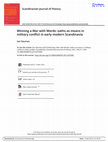
Scandinavian Journal of History, 2014
From a distance, the many wars that took place during the early modern period were
fought by king... more From a distance, the many wars that took place during the early modern period were
fought by kings and armies, conquering territories and losing them, signing peace treaties
and breaking them. Wars fought with armies were, however, costly and, if possible, the
rulers did what they could to avoid them while still trying to acquire and protect
territories. One strategy employed was to persuade the people of a disputed territory to
surrender to the conquering state by swearing an oath of allegiance to its king. Seen in this
perspective, territories could be acquired and lost by using the oaths as means in military
conflict. The following article discusses the role of oaths in keeping and conquering
territories in the early modern Scandinavian countries, with a special focus on Sweden and
to some degree Sweden’s constant enemy during this period, Denmark-Norway. It also
studies the same oaths from the people’s point of view, and what happened after an oath
was sworn and the war ended. By taking examples from areas under dispute, the article
investigates how oaths could be used by both authorities and subjects in warfare and after
in the early modern context.


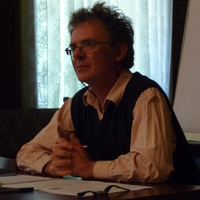








Uploads
Books by Sari Nauman
Included are investigations of the usage and multiple meanings of the term itself – the private – following traces in private conversations, parliamentary debates, letters, court records and newspapers. This linguistic perspective is combined with a conceptual and physical one, studying buildings and floor plans, furniture, ordinances and corruption. Most chapters centre on the major cities of the region – Copenhagen and Stockholm – but other cities as well as rural life are considered.
Private actions and private lives took place within public actions and public lives, not in isolation from them. By looking at the interaction between private and public, rather than treating the two notions as distinct and antagonistic, the studies collected here let us see how early modern people navigated the private aspects of life, along with all the potential dangers and benefits that accompanied them.
The main purpose of this dissertation is to analyse why political oaths were used in Sweden in the sixteenth and seventeenth centuries, as well as to explain why the usages changed. It is argued that oaths were performative means of instilling trust in a political relationship. Trust was accomplished by an oral utterance, during which the swearer claimed the position of a trustworthy subject. The study encompasses not only how the force of oaths was created, but also how uncertainty regarding the subject’s trustworthiness was handled, by examining its usage in coronations, rebellions, wars and political meetings.
The dissertation has four conclusions. First, not only the use of oaths but also the oath event itself underwent changes during the period studied, leading to changes in its performative force. Second, the shaping of the oath event depended on the degree of uncertainty in the specific political relationship. Third, while in the sixteenth century oaths were used to establish trust in political relationships, in the seventeenth century they were re-directed to establish control. Fourth, the shift from trust to control reflected the rise of a written political culture. When political relationships shifted from being characterized by presence and personal contact, to being characterized by distance and impersonal delegation, written oaths were better suited to the situation. Ultimately, the written form transformed the action, for the ability of a political oath to instil trust was linked to its orality. What a written oath could do, though, was help establish control.
Bokens författare är alla tidigare eller nuvarande doktorander till Maria Sjöberg, professor i historia vid Göteborgs universitet.
Men rumsliga och tidsliga skillnader inom diplomati har också överdrivits. Därför presenterar historikerna Susanna Erlandsson och Sari Nauman i den här diskussionsboken en begreppsapparat som möjliggör såväl diakrona som synkrona jämförelser av diplomatiska praktiker. Sökljuset riktas bort från stater och officiella aktörer, som är svåra att definiera för tidigare perioder, mot individuella aktörer och deras personliga relationer med varandra. Frågan om hur individerna gör för att skapa tillit inom den diplomatiska relationen placeras i fokus. Medan behovet av tillit ständigt är aktuellt, är metoderna för att uppnå den kontextberoende. Därmed möjliggör begreppsapparaten såväl jämförelser över tid och rum som studier av kontinuitet och förändring.
Begreppsapparaten testas av sex framstående diplomatihistoriker på skilda historiska perioder och kontexter. Tillsammans demonstrerar de begreppens potential och deras fortsatta utmaningar.
Articles & Chapters by Sari Nauman
Starting with ordinances and instructions, Nauman investigates the authorities’ perspective in trying to safeguard their communities at the arrival of thousands of refugees during wartime. The refugee’s perspective is analysed through petitions and letters of grievances sent to worldly and ecclesiastical authorities.
Private actions and private lives took place within public actions and public lives, not in isolation from them. By looking at the interaction between private and public, rather than treating the two notions as distinct and antagonistic, this introduction highlights how early modern people navigated the private aspects of life, along with all the potential dangers and benefits that accompanied them.
I propose that the concept of recognition can be used to challenge the perception of states as sovereign and continuous entities and highlight challenges towards the statebuilding process. Based on a case study in Sweden 1719, I show how states’ recognition of subjects’ political agency enabled negotiations during wartime rebellions. Furthermore, subjects could withhold or retract their recognition of a state. Their actions signalled the breakdown of the sovereign state, at least temporarily, and thwarted the statebuilding process.
However, the case study also demonstrates the shortcomings of the port city’s control network. Had Annika timed her journey better and been better informed on the politics of the city, she might have managed to slip through. As shown in the study, the city inhabitants were generally willing to help the passing stranger, especially if they could expect compensation, even if this meant breaking the law. As such, the investigation demonstrates the conditions as well as social costs of fleeting hospitality and civil inattention.
fought by kings and armies, conquering territories and losing them, signing peace treaties
and breaking them. Wars fought with armies were, however, costly and, if possible, the
rulers did what they could to avoid them while still trying to acquire and protect
territories. One strategy employed was to persuade the people of a disputed territory to
surrender to the conquering state by swearing an oath of allegiance to its king. Seen in this
perspective, territories could be acquired and lost by using the oaths as means in military
conflict. The following article discusses the role of oaths in keeping and conquering
territories in the early modern Scandinavian countries, with a special focus on Sweden and
to some degree Sweden’s constant enemy during this period, Denmark-Norway. It also
studies the same oaths from the people’s point of view, and what happened after an oath
was sworn and the war ended. By taking examples from areas under dispute, the article
investigates how oaths could be used by both authorities and subjects in warfare and after
in the early modern context.
Included are investigations of the usage and multiple meanings of the term itself – the private – following traces in private conversations, parliamentary debates, letters, court records and newspapers. This linguistic perspective is combined with a conceptual and physical one, studying buildings and floor plans, furniture, ordinances and corruption. Most chapters centre on the major cities of the region – Copenhagen and Stockholm – but other cities as well as rural life are considered.
Private actions and private lives took place within public actions and public lives, not in isolation from them. By looking at the interaction between private and public, rather than treating the two notions as distinct and antagonistic, the studies collected here let us see how early modern people navigated the private aspects of life, along with all the potential dangers and benefits that accompanied them.
The main purpose of this dissertation is to analyse why political oaths were used in Sweden in the sixteenth and seventeenth centuries, as well as to explain why the usages changed. It is argued that oaths were performative means of instilling trust in a political relationship. Trust was accomplished by an oral utterance, during which the swearer claimed the position of a trustworthy subject. The study encompasses not only how the force of oaths was created, but also how uncertainty regarding the subject’s trustworthiness was handled, by examining its usage in coronations, rebellions, wars and political meetings.
The dissertation has four conclusions. First, not only the use of oaths but also the oath event itself underwent changes during the period studied, leading to changes in its performative force. Second, the shaping of the oath event depended on the degree of uncertainty in the specific political relationship. Third, while in the sixteenth century oaths were used to establish trust in political relationships, in the seventeenth century they were re-directed to establish control. Fourth, the shift from trust to control reflected the rise of a written political culture. When political relationships shifted from being characterized by presence and personal contact, to being characterized by distance and impersonal delegation, written oaths were better suited to the situation. Ultimately, the written form transformed the action, for the ability of a political oath to instil trust was linked to its orality. What a written oath could do, though, was help establish control.
Bokens författare är alla tidigare eller nuvarande doktorander till Maria Sjöberg, professor i historia vid Göteborgs universitet.
Men rumsliga och tidsliga skillnader inom diplomati har också överdrivits. Därför presenterar historikerna Susanna Erlandsson och Sari Nauman i den här diskussionsboken en begreppsapparat som möjliggör såväl diakrona som synkrona jämförelser av diplomatiska praktiker. Sökljuset riktas bort från stater och officiella aktörer, som är svåra att definiera för tidigare perioder, mot individuella aktörer och deras personliga relationer med varandra. Frågan om hur individerna gör för att skapa tillit inom den diplomatiska relationen placeras i fokus. Medan behovet av tillit ständigt är aktuellt, är metoderna för att uppnå den kontextberoende. Därmed möjliggör begreppsapparaten såväl jämförelser över tid och rum som studier av kontinuitet och förändring.
Begreppsapparaten testas av sex framstående diplomatihistoriker på skilda historiska perioder och kontexter. Tillsammans demonstrerar de begreppens potential och deras fortsatta utmaningar.
Starting with ordinances and instructions, Nauman investigates the authorities’ perspective in trying to safeguard their communities at the arrival of thousands of refugees during wartime. The refugee’s perspective is analysed through petitions and letters of grievances sent to worldly and ecclesiastical authorities.
Private actions and private lives took place within public actions and public lives, not in isolation from them. By looking at the interaction between private and public, rather than treating the two notions as distinct and antagonistic, this introduction highlights how early modern people navigated the private aspects of life, along with all the potential dangers and benefits that accompanied them.
I propose that the concept of recognition can be used to challenge the perception of states as sovereign and continuous entities and highlight challenges towards the statebuilding process. Based on a case study in Sweden 1719, I show how states’ recognition of subjects’ political agency enabled negotiations during wartime rebellions. Furthermore, subjects could withhold or retract their recognition of a state. Their actions signalled the breakdown of the sovereign state, at least temporarily, and thwarted the statebuilding process.
However, the case study also demonstrates the shortcomings of the port city’s control network. Had Annika timed her journey better and been better informed on the politics of the city, she might have managed to slip through. As shown in the study, the city inhabitants were generally willing to help the passing stranger, especially if they could expect compensation, even if this meant breaking the law. As such, the investigation demonstrates the conditions as well as social costs of fleeting hospitality and civil inattention.
fought by kings and armies, conquering territories and losing them, signing peace treaties
and breaking them. Wars fought with armies were, however, costly and, if possible, the
rulers did what they could to avoid them while still trying to acquire and protect
territories. One strategy employed was to persuade the people of a disputed territory to
surrender to the conquering state by swearing an oath of allegiance to its king. Seen in this
perspective, territories could be acquired and lost by using the oaths as means in military
conflict. The following article discusses the role of oaths in keeping and conquering
territories in the early modern Scandinavian countries, with a special focus on Sweden and
to some degree Sweden’s constant enemy during this period, Denmark-Norway. It also
studies the same oaths from the people’s point of view, and what happened after an oath
was sworn and the war ended. By taking examples from areas under dispute, the article
investigates how oaths could be used by both authorities and subjects in warfare and after
in the early modern context.
were contingent, and in many cases among aliens probably more local than national. The social impacts of war in modern-day west Sweden extended beyond the towns directly affected, such as Nya Lödöse and Ny Varberg. The degree to which individuals could act with agency and autonomy was contingent and context-specific. Forced migration and the negotiation of identity are issues that remain relevant today; questions of memory, property, trauma, history, and narratives are still debated by combatants and non-combatants. Many of the issues which both civilians and military, men and women, experienced in the sixteenth- and seventeenth-century wars between Sweden and Denmark-Norway are much the same as in more recent times. The social impacts of war in the seventeenth century were no less than those experienced in the
twentieth and twenty-first centuries.
Organizers: Sari Nauman (Uni Gothenburg), Olof Blomqvist (Uni Gothenburg), Susanne Lachenicht (Uni Bayreuth), Thomas Mareite (Uni Tübingen), Megan Maruschke (Uni Leipzig)
This work is licensed under a Creative Commons Attribution-NonCommercial-NoDerivatives 4.0 International License.